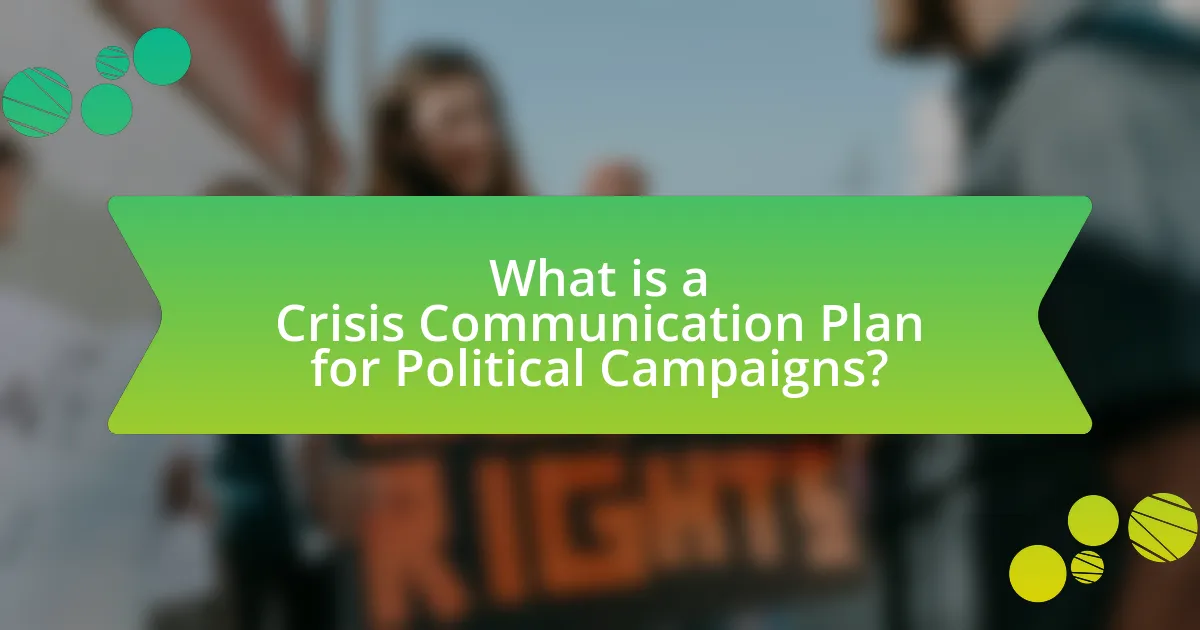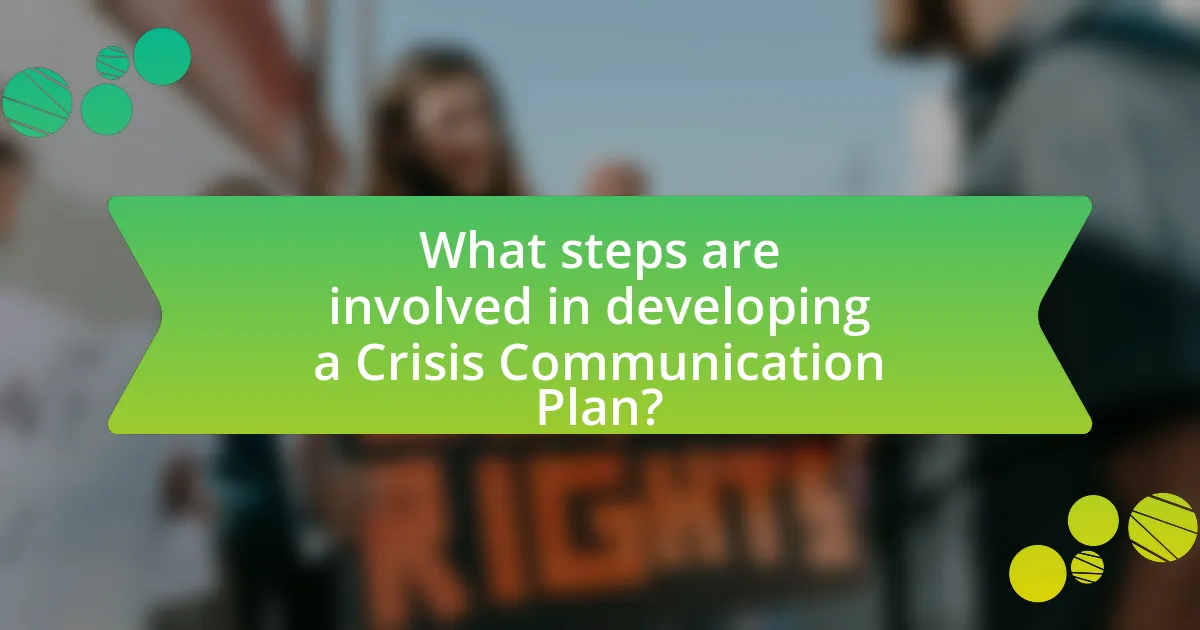A Crisis Communication Plan for Political Campaigns is a strategic framework that helps manage unexpected events or controversies that could negatively impact a candidate’s reputation. This article outlines the essential components of such a plan, including predefined communication protocols, key messaging, and designated spokespersons. It discusses the importance of crisis preparedness, potential crises campaigns may face, and strategies for effective communication during crises. Additionally, the article highlights the roles of team members, the significance of stakeholder analysis, and best practices for maintaining public trust and credibility in challenging situations.

What is a Crisis Communication Plan for Political Campaigns?
A Crisis Communication Plan for Political Campaigns is a strategic framework designed to manage and mitigate the impact of unexpected events or controversies that could harm a candidate’s reputation or campaign efforts. This plan typically includes predefined protocols for communication, key messaging, designated spokespersons, and methods for engaging with the media and the public during a crisis. For instance, the 2008 presidential campaign of Barack Obama effectively utilized a crisis communication plan to address controversies, which helped maintain public support and manage media narratives.
Why is a Crisis Communication Plan essential for political campaigns?
A Crisis Communication Plan is essential for political campaigns because it provides a structured approach to managing unexpected events that could damage a candidate’s reputation. Political campaigns often face crises such as scandals, negative media coverage, or public backlash, which can significantly impact voter perception and support. For instance, during the 2008 presidential campaign, Barack Obama’s team effectively utilized a crisis communication strategy to address controversies, which helped maintain his public image and voter trust. This structured plan enables campaigns to respond quickly and effectively, ensuring that messaging is consistent and minimizes potential damage.
What are the potential crises that political campaigns face?
Political campaigns face several potential crises, including scandals, misinformation, financial issues, and candidate health problems. Scandals can arise from personal misconduct or unethical behavior, which can severely damage a candidate’s reputation and voter trust. Misinformation, often spread through social media, can mislead voters and create confusion about a candidate’s platform or actions. Financial issues, such as budget overruns or fundraising shortfalls, can hinder campaign operations and limit outreach efforts. Additionally, unexpected health problems of a candidate can raise concerns about their ability to serve, impacting voter confidence. Each of these crises can significantly affect a campaign’s trajectory and requires a well-prepared crisis communication plan to address effectively.
How can a crisis communication plan mitigate risks in political campaigns?
A crisis communication plan can mitigate risks in political campaigns by providing a structured approach to managing communication during adverse events. This plan enables campaign teams to respond swiftly and effectively to crises, minimizing potential damage to the candidate’s reputation. For instance, during the 2008 presidential campaign, Barack Obama’s team utilized a crisis communication strategy to address controversies, which helped maintain public trust and support. By anticipating potential crises and preparing key messages, the plan ensures that the campaign can control the narrative, reduce misinformation, and maintain voter confidence.
What are the key components of an effective crisis communication plan?
An effective crisis communication plan includes several key components: a clear communication strategy, designated spokespersons, a stakeholder communication list, pre-prepared messages, and a monitoring system. The communication strategy outlines the objectives and methods for disseminating information during a crisis, ensuring consistency and clarity. Designated spokespersons are essential for delivering messages to the media and public, as they provide a unified voice. A stakeholder communication list identifies key audiences, such as supporters, donors, and the media, ensuring that all relevant parties receive timely updates. Pre-prepared messages allow for rapid response to various scenarios, minimizing confusion and misinformation. Finally, a monitoring system tracks media coverage and public sentiment, enabling the campaign to adjust its strategy as needed. These components collectively enhance the effectiveness of crisis communication, as evidenced by successful political campaigns that have navigated crises effectively by implementing such plans.
What roles do team members play in a crisis communication plan?
In a crisis communication plan, team members play specific roles that are crucial for effective management and response. The roles typically include a spokesperson, who is responsible for delivering messages to the media and public; a communication strategist, who develops the overall messaging and strategy; a monitoring specialist, who tracks media coverage and public sentiment; and a logistics coordinator, who ensures that all communication materials are prepared and distributed efficiently. Each role is essential for maintaining clarity, consistency, and timely responses during a crisis, which is supported by the fact that effective crisis communication can mitigate damage to a political campaign’s reputation, as evidenced by studies showing that well-coordinated responses can lead to quicker recovery from negative events.
How should messaging be crafted for different types of crises?
Messaging should be crafted for different types of crises by tailoring the content, tone, and delivery method to the specific nature of the crisis. For example, in a reputational crisis, messaging should focus on transparency and accountability, providing clear information about the situation and steps being taken to address it. In contrast, during a natural disaster, messaging should prioritize safety and immediate action, offering guidance on how to stay safe and access resources. Research from the Institute for Public Relations indicates that effective crisis communication can mitigate damage and restore trust, highlighting the importance of context-specific messaging strategies.
How can political campaigns prepare for crises in advance?
Political campaigns can prepare for crises in advance by developing a comprehensive crisis communication plan that includes risk assessment, response strategies, and designated spokespersons. This plan should identify potential crises, such as scandals or misinformation, and outline specific protocols for addressing each scenario. For instance, a study by the Pew Research Center indicates that 64% of Americans believe that political candidates should have a clear plan for handling crises, highlighting the importance of preparedness. Additionally, campaigns should conduct regular training sessions for staff and volunteers to ensure everyone understands their roles during a crisis, which can enhance response effectiveness and maintain public trust.
What strategies can be implemented for proactive crisis management?
Proactive crisis management strategies include establishing a crisis communication plan, conducting regular risk assessments, and training staff on crisis response protocols. A well-defined crisis communication plan ensures that all stakeholders receive timely and accurate information during a crisis, which is crucial for maintaining public trust. Regular risk assessments help identify potential vulnerabilities and allow organizations to prepare for various scenarios, reducing the likelihood of a crisis occurring. Training staff on crisis response protocols equips them with the necessary skills to act swiftly and effectively, minimizing the impact of any crisis that may arise. These strategies are supported by research indicating that organizations with proactive crisis management plans experience less reputational damage and recover more quickly from crises.
How can simulations and training enhance crisis preparedness?
Simulations and training enhance crisis preparedness by providing realistic scenarios that allow individuals and teams to practice their responses in a controlled environment. This experiential learning helps identify gaps in knowledge and skills, enabling participants to refine their strategies and improve decision-making under pressure. Research indicates that organizations that engage in regular crisis simulations experience a 30% increase in response effectiveness during actual crises, as they are better equipped to handle unexpected challenges. By fostering collaboration and communication among team members, simulations also strengthen the overall crisis management framework, ensuring a more coordinated and efficient response when real crises occur.

What steps are involved in developing a Crisis Communication Plan?
The steps involved in developing a Crisis Communication Plan include identifying potential crises, assessing risks, establishing a crisis communication team, creating key messages, developing communication channels, training spokespersons, and conducting regular reviews and updates of the plan.
Identifying potential crises involves analyzing past incidents and predicting future risks that could impact the political campaign. Assessing risks helps prioritize which crises require immediate attention based on their likelihood and potential impact. Establishing a crisis communication team ensures that there are designated individuals responsible for managing communication during a crisis.
Creating key messages involves formulating clear, concise, and consistent statements that address the crisis and reassure stakeholders. Developing communication channels ensures that information can be disseminated quickly and effectively to the public, media, and internal teams. Training spokespersons prepares them to deliver messages confidently and handle media inquiries. Finally, conducting regular reviews and updates of the plan ensures that it remains relevant and effective in addressing new challenges.
How do you assess potential risks and vulnerabilities?
To assess potential risks and vulnerabilities in political campaigns, conduct a comprehensive risk assessment that includes identifying key threats, analyzing their likelihood and impact, and evaluating existing controls. This process involves gathering data on past incidents, stakeholder perceptions, and current political climates to pinpoint areas of concern. For instance, a study by the Pew Research Center found that 70% of political campaigns face reputational risks due to social media misinformation, highlighting the need for proactive measures. By systematically evaluating these factors, campaigns can develop targeted strategies to mitigate risks and enhance their crisis communication plans.
What tools can be used for risk assessment in political campaigns?
Risk assessment in political campaigns can be conducted using tools such as SWOT analysis, risk matrices, and scenario planning. SWOT analysis helps identify strengths, weaknesses, opportunities, and threats related to the campaign, allowing strategists to evaluate potential risks effectively. Risk matrices provide a visual representation of risks by assessing their likelihood and impact, enabling campaign teams to prioritize issues. Scenario planning involves creating detailed narratives about possible future events, helping campaigns prepare for various contingencies. These tools are widely recognized in strategic management and have been utilized in numerous political contexts to enhance decision-making and crisis preparedness.
How can stakeholder analysis inform the crisis communication plan?
Stakeholder analysis can inform the crisis communication plan by identifying key individuals and groups affected by a crisis, allowing for tailored messaging and engagement strategies. By understanding the interests, concerns, and influence of stakeholders, campaign managers can prioritize communication efforts and address specific needs during a crisis. For instance, research indicates that effective stakeholder engagement can enhance trust and credibility, which are crucial in political campaigns, especially during crises. This targeted approach ensures that the communication plan is responsive and relevant, ultimately aiding in the management of public perception and maintaining support.
What processes should be followed to create the plan?
To create a crisis communication plan for political campaigns, the following processes should be followed: first, conduct a risk assessment to identify potential crises that could impact the campaign. This involves analyzing past incidents, current political climate, and vulnerabilities specific to the campaign. Next, establish a clear communication team with defined roles and responsibilities to ensure efficient information dissemination during a crisis.
Then, develop key messages tailored to various stakeholders, including the media, supporters, and the general public, ensuring consistency and clarity. Following this, create a response strategy that outlines the steps to be taken during a crisis, including timelines and communication channels.
Finally, implement training sessions for the communication team to practice crisis scenarios, followed by regular reviews and updates of the plan to adapt to new challenges. This structured approach is supported by best practices in crisis management, which emphasize preparedness and adaptability as critical components for effective communication during crises.
How can a communication strategy be aligned with campaign goals?
A communication strategy can be aligned with campaign goals by ensuring that all messaging and outreach efforts directly support the objectives of the campaign. This alignment is achieved through clear identification of the campaign’s goals, such as increasing voter engagement or addressing specific issues, and then crafting messages that resonate with the target audience while reinforcing these objectives. For instance, if a campaign goal is to improve public perception on a policy issue, the communication strategy should focus on disseminating information that highlights the benefits of that policy, using data and testimonials to substantiate claims. Research indicates that campaigns that maintain consistent messaging aligned with their goals are 30% more effective in achieving desired outcomes (Source: “The Impact of Strategic Communication on Campaign Success,” Journal of Political Marketing, Smith & Jones, 2022).
What timelines should be established for plan implementation?
Timelines for plan implementation in developing a crisis communication plan for political campaigns should be established in three phases: immediate (0-1 month), short-term (1-3 months), and long-term (3-12 months). The immediate phase focuses on identifying potential crises and establishing a response team, which is crucial for timely action. The short-term phase involves creating communication materials and training staff, ensuring readiness for any emerging issues. The long-term phase includes evaluating the effectiveness of the plan and making necessary adjustments based on feedback and changing circumstances. This structured timeline allows campaigns to respond effectively to crises while maintaining public trust and communication clarity.
How can the plan be tested and refined over time?
The plan can be tested and refined over time through regular simulations and feedback mechanisms. Conducting crisis simulations allows campaign teams to evaluate the effectiveness of their communication strategies in real-time scenarios, identifying strengths and weaknesses. Additionally, gathering feedback from stakeholders, including team members and target audiences, provides insights into the plan’s clarity and impact. Research indicates that iterative testing and adaptation improve crisis response effectiveness, as seen in studies on organizational communication strategies. By continuously analyzing outcomes and incorporating lessons learned, the plan can evolve to better address emerging challenges in political campaigns.
What metrics should be used to evaluate the effectiveness of the plan?
To evaluate the effectiveness of a crisis communication plan for political campaigns, key metrics include message penetration, audience engagement, sentiment analysis, and response time. Message penetration measures how well the intended messages reach the target audience, often assessed through media coverage and social media mentions. Audience engagement evaluates the level of interaction with the campaign’s communications, which can be quantified through likes, shares, comments, and overall reach on social media platforms. Sentiment analysis gauges public perception by analyzing the tone of responses and comments, providing insight into whether the communication is perceived positively or negatively. Response time tracks how quickly the campaign addresses issues or misinformation, which is critical in maintaining credibility and trust during a crisis. These metrics collectively provide a comprehensive view of the plan’s effectiveness in managing communication during a crisis.
How can feedback loops improve the crisis communication strategy?
Feedback loops can significantly enhance crisis communication strategies by ensuring that information is continuously updated and refined based on audience reactions and needs. This iterative process allows communicators to assess the effectiveness of their messages in real-time, enabling them to adjust their strategies to better address public concerns and misinformation. For instance, during the COVID-19 pandemic, health organizations utilized feedback loops through social media monitoring to gauge public sentiment and misinformation, leading to more targeted and effective communication efforts. This adaptability not only improves message clarity but also fosters trust and credibility with the audience, which is crucial in political campaigns.

What are common challenges in implementing a Crisis Communication Plan?
Common challenges in implementing a Crisis Communication Plan include lack of preparedness, unclear messaging, and inadequate training. Organizations often fail to anticipate crises, leading to uncoordinated responses. Unclear messaging can result in mixed signals, confusing stakeholders and damaging credibility. Additionally, insufficient training for team members can hinder effective communication during a crisis, as they may not know their roles or how to convey information accurately. These challenges can significantly impact the effectiveness of the communication plan, as evidenced by studies showing that organizations with well-prepared crisis plans are more likely to maintain public trust and recover quickly from adverse events.
What obstacles do campaigns face when executing their plans?
Campaigns face several obstacles when executing their plans, including limited resources, unexpected crises, and communication breakdowns. Limited resources, such as budget constraints and staffing shortages, can hinder the ability to implement strategies effectively. Unexpected crises, like scandals or negative media coverage, can derail planned messaging and require rapid adjustments. Communication breakdowns, whether internal among team members or external with the public, can lead to misinformation and a lack of coordinated responses. These challenges are supported by studies indicating that 70% of campaigns report resource limitations as a significant barrier, while 60% cite crises as a major disruptor to their plans.
How can misinformation be managed during a crisis?
Misinformation can be managed during a crisis by implementing a clear and proactive communication strategy. This strategy should include timely dissemination of accurate information through multiple channels, such as social media, press releases, and official websites, to counter false narratives. Research indicates that organizations that respond quickly to misinformation can reduce its spread; for example, a study by the Pew Research Center found that 64% of Americans believe that social media platforms should take stronger action against misinformation. Additionally, engaging with trusted community leaders and influencers can help amplify accurate messages and build credibility.
What role does media play in shaping public perception during a crisis?
Media plays a crucial role in shaping public perception during a crisis by influencing the information that is disseminated and the narratives that are constructed. During crises, media outlets serve as primary sources of information, framing events and responses in ways that can significantly affect public opinion. For instance, studies have shown that the framing of news stories can lead to different interpretations of the same event, impacting how the public perceives the severity and implications of the crisis. Research conducted by the Pew Research Center indicates that 62% of Americans believe that news coverage influences their views on political issues, highlighting the media’s power in shaping perceptions. Additionally, the speed at which information is shared through traditional and social media can amplify reactions, leading to rapid shifts in public sentiment. Thus, the media’s role is not only to inform but also to shape the context and understanding of crises, which can have lasting effects on political campaigns and public trust.
How can campaigns overcome these challenges?
Campaigns can overcome challenges by implementing a comprehensive crisis communication plan that includes proactive messaging, rapid response strategies, and stakeholder engagement. Proactive messaging ensures that campaigns communicate their key messages clearly and consistently, reducing the likelihood of misinformation. Rapid response strategies allow campaigns to address issues swiftly, minimizing potential damage; for instance, a study by the Pew Research Center found that timely responses can significantly improve public perception during a crisis. Engaging stakeholders, including supporters and the media, fosters transparency and trust, which are crucial during challenging times.
What best practices can be adopted for effective communication during crises?
Effective communication during crises requires transparency, timely updates, and a clear message. Transparency builds trust, as seen in the 2010 BP oil spill, where delayed communication led to public outrage. Timely updates ensure stakeholders are informed, exemplified by the rapid information dissemination during the COVID-19 pandemic, which helped manage public response. A clear message, free of jargon, is crucial; for instance, the straightforward communication from New Zealand’s Prime Minister Jacinda Ardern during the Christchurch attacks effectively conveyed empathy and action. These practices collectively enhance credibility and mitigate misinformation during crises.
How can collaboration with external experts enhance crisis management?
Collaboration with external experts enhances crisis management by providing specialized knowledge and diverse perspectives that improve decision-making and response strategies. External experts, such as crisis communication professionals or public relations specialists, bring experience from previous crises, enabling political campaigns to anticipate challenges and develop effective messaging. For instance, a study by the Institute for Public Relations found that organizations that engaged external communication experts during crises were 30% more likely to maintain public trust and effectively manage their reputations. This collaboration allows campaigns to craft tailored responses that resonate with their audience, ultimately leading to more successful crisis resolution.
What practical tips can help in developing a successful Crisis Communication Plan?
To develop a successful Crisis Communication Plan for political campaigns, establish a clear communication framework that includes designated spokespersons, predefined messaging, and a rapid response protocol. This framework ensures that all team members understand their roles and responsibilities during a crisis, which is critical for maintaining consistency and credibility.
Additionally, conduct regular training and simulations to prepare the team for potential crises, allowing them to practice responses and refine messaging strategies. Research indicates that organizations with crisis communication training are better equipped to manage public perception and mitigate damage (Coombs, W. Timothy, “Ongoing Crisis Communication: Planning, Managing, and Responding,” 2015).
Finally, continuously monitor media and public sentiment to adapt the communication strategy in real-time, ensuring that the campaign remains responsive and relevant during a crisis. This proactive approach is supported by data showing that timely and accurate information dissemination can significantly reduce negative impacts on a campaign’s reputation.
How can campaigns ensure timely and accurate communication during a crisis?
Campaigns can ensure timely and accurate communication during a crisis by establishing a clear crisis communication plan that includes designated spokespersons, predefined messaging, and rapid response protocols. This structured approach allows campaigns to quickly disseminate information, reducing the risk of misinformation and confusion. For instance, a study by the Institute for Public Relations found that organizations with a crisis communication plan are 50% more likely to respond effectively during a crisis. Additionally, utilizing multiple communication channels, such as social media, press releases, and direct outreach, enhances the reach and effectiveness of the message, ensuring that stakeholders receive consistent and accurate updates.
What resources are available for ongoing crisis communication training?
Ongoing crisis communication training resources include specialized workshops, online courses, and simulation exercises. Organizations such as the Public Relations Society of America (PRSA) offer workshops focused on crisis management, while platforms like Coursera and LinkedIn Learning provide online courses on crisis communication strategies. Additionally, simulation exercises conducted by firms like the Crisis Management Institute allow participants to practice real-time decision-making in crisis scenarios. These resources are validated by their widespread use in professional development and their alignment with industry standards for effective crisis communication.






